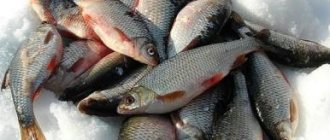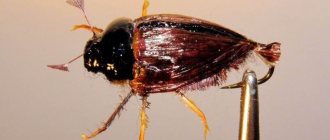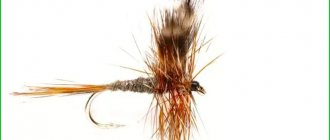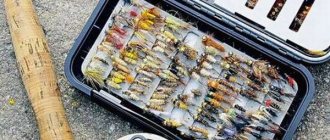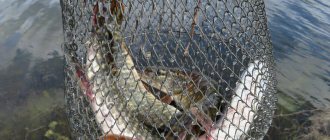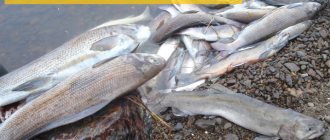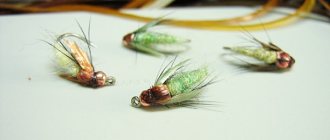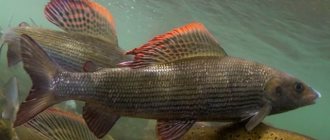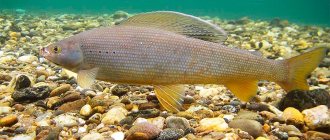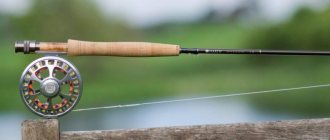Fly fishing - description of the technique and secrets of fishing with a spinning rod and fishing rod (130 photos + video)
Modern anglers have a large number of options at their disposal when selecting gear.
However, very few people understand how to understand this wide range. It is especially difficult for beginners in fishing to decide on suitable gear, since they still have no idea how and what to fish for this or that prey.
Often, when choosing the right gear, the most pressing issue is the selection of bait. There are a lot of options, for example, wobblers, spinners, flies and other options known to everyone.
Fishing with a fly with a float or using a spinning rod is a very interesting topic for beginners.
Professionals prefer fly fishing and it is truly more effective when you master the skill well. And for those who are just starting out, the front sight is considered the most suitable option.
In our article we will talk about fly fishing in winter and at any other time, as well as about the correct choice of this bait.
Varieties of flies
Fly fishing is a very productive activity and brings big catches. A fly is an artificial bait that imitates a natural insect.
Many of the fish that fishermen hunt are predators. These are, for example, pike, perch, asp, pike perch and many others. All of them have animal food in their diet, a large share of which comes from insect larvae and the insects themselves.
Many insects lay eggs in the water column and on the bottom, where they gradually grow and turn into larvae, then in the process of development they rise to the surface.
In addition, insects often simply fall into bodies of water and cannot get out, which makes them prey for predatory fish. It is precisely these options that the bait called the fly imitates.
There are various varieties of flies that resemble insects in different stages of development. There are options that are identical to insect larvae of different species.
There are also nymphs - these are larvae that are slightly above the bottom, and those that are preparing to fly out of the water - these are suspenders.
Wet and dry insects are also relevant; they are caught near the surface and on the surface itself. Among the flies there are also streamers - imitation of small fish and fry.
How to fish with a fly using a spinning rod
Fly fishing with a spinning rod is the most common way to use this bait.
When used in this variation, you can choose one of the types of front sight mounts. This is either installation directly on the spoon, or putting it on a hook directly outside the spoon.
Thus, in any case, the fly will be ideal for catching predators.
This method attracts small predators such as trout, chub, and grayling. In order to organize this, you need to thread the fly into the top ring of the spinner.
But in the case of a large predator, attaching the fly to a hook is better suited. So it will look like a small fish with a bright tail. Here the fastening is simple and clear, even a beginner can handle it. This is the best fly for catching perch or pike.
Choosing a fly for fishing
Of course, a lot depends on the fishing method, so first of all you should pay attention to this fact. However, if the midge is chosen incorrectly, then the catch will not be large.
So, first of all, the bait itself is selected, depending on weather conditions, time of year and much more.
However, if the midge is chosen incorrectly, then the catch will not be large. So, first of all, the bait itself is selected, depending on weather conditions, time of year and much more.
In daylight, that is, during the day, dark-colored flies that are not conspicuous will be preferable. In the dark twilight time, accordingly, light flies are used.
And if fishing is carried out at night, then large white flies will be most relevant. The fly fishing video shows exactly how to choose.
The same thing can be noticed with changing weather. But the most important thing is the time of year you fish.
If it’s spring outside, then choose imitation nymphs and insect larvae.
In the summer, the option is taken that copies flying insects, and by the end of summer and early autumn, dry and wet flies are used.
Cold time is a period when only gray small midges remain, and they are taken as a basis.
Dry and wet flies: two different ways of fishing
Wet fly fishing is the oldest form of fly fishing. Long before the first attempts were made to catch fish with a dry fly drifting on the surface of the water, wet flies were already well known. Many ancient samples have come down to us in Ronald’s book “Fly Fishing Entomology,” although written in 1836, it has not lost its interest and relevance today. If you evaluate the ability of these ancient English specimens to attract fish, it turns out that they have not lost it even now. Many sport anglers on both sides of the Atlantic still have a lot of fun using these classic flies.
Fishing with a wet fly is as interesting as it is effective. It is known that salmon satisfy 80% of their need for food by hunting underwater. Many of them feed only under water. Over the years, in continental Europe and North America, traditional wet fly fishing has given way to the more fashionable nymph fishing. In Great Britain and Ireland, on the contrary, traditional wet fly fishing, especially in the bays of Scotland, has not lost its popularity.
Fly fishermen are constantly creating new patterns that imitate all the rich life of aquatic insects and small crustaceans that fish see in the water. Particularly attractive are soft and smoother flies that move in the water as if they were alive. Many successful anglers use flies that imitate the most popular seasonal foods. There are also “permanent” fly patterns that you can try to use at any time of the year. Fish sometimes mistakes wet flies for insects that have fallen into the water.
In fast water, wet flies are most often used alone. Fishing takes place just below the surface or at great depths. According to the classical school, they are cast against the current, and the fly is fed downstream. It is very important not to impede their movements during the current, and then, at the end of the drift, carefully return them to their place. It is also recommended to complete each retrieve, because often the fish takes precisely in the last phase. It's always nice to cast a fly against the current to the fish, but this technique requires a keen eye and quick reaction.
In low water it is best to fish with a floating line, while deeper water requires a sinking line or a special line with a sinking tip. A fast rod 2.5 - 3 meters long with a class 5 - 6 cord most successfully meets the request for placing a fly and selecting a cord.
In still water, the fly should be presented in motion. After casting, it must be moved slowly, with short jerking movements. In deeper water, a sinking line is also used. In large open spaces, a rod longer than 2.7 meters should be used. If the flies are placed close to the surface of the water, the taking fish sometimes even sticks out of the water to get them. If the fish takes it, then you should hook it carefully, but firmly, lifting the end of the rod and at the same time pulling out the cord. In deep water, the fish, before taking it, seems to bite the fly, which can be felt by the line. Further cutting is done in the same way. In fast water, the fish often hooks itself. But still, the advice is to make a small control hook, since it often happens that it comes off with further fishing.
Fishing with dry flies attracts fly fishermen the most. Many people believe that this is what real fly fishing is. The reason for this popularity is quite clear. All events that happen during dry fly fishing happen in plain sight. This gets our attention because we are “looking animals.” On top of that, there is an element of play and, if you like, show in all this. Fly fishing is beautiful, elegant and entertaining and can offer you all the delights that other forms of fishing can provide. Naturally, anyone can get into it!
However, dry fly fishing is not the most difficult type of fly fishing. The casting of the fly is clearly visible, and an error in the feed is detected immediately. Provided that the angler knows the habits of insects well, it is quite easy to “adjust” the feed to the requirements of the fish. The initial motivation for dry fly fishing was observing insect activity on the surface of the water. The various stages of development in the insect world and, especially, the life cycles of species living in water, have left their “traces” on dry fly patterns, as well as dry fly fishing tactics. The constant relationship with the world of insects has made many fishermen become seriously interested in entomology.
Of course, the more similar the fly and its presentation method are to the original, the faster the fish bites. The presence of insects on the surface of the water depends to a certain extent on the various stages of their life. At the end of their larval phase, the nymphs rise to the surface of the water to shed their “shells” and complete their life cycle as winged insects. When they are ready to lay eggs, they return to the water. Fish rise up for both types: those that hatch and those that lay eggs. Land insects that fall into the water also instantly become prey for fish. Many flies are created based on models of land insects, and their share in the total number of baits is large.
The ideal circumstances for fishing are when the fish are active near the surface of the water. When there are no circles on the surface of the water, you can rely on chance, especially in “tested” places. But the fly, in this case, must float well, and it must be presented directly on the surface of the water or just below it. A floating line and long leader should be used.
In fast water, the fly is usually cast against or across the current. This is also the best way to get close to the fish without being noticed. The fly is cast upstream and allowed to drift freely downstream to where the fish are. It all depends on the accuracy of the cast, the correct drift and, of course, on whether the fly is chosen correctly. It is better to make a choice by observing insects in the water, rather than trying different models.
The period of time between casting a fly and the fish rising to it is one of the most delightful moments in fishing. Will the fish rise? If it rises, will it take the bait? If he takes it, then not too strong a tug on the cord will be enough. As a rule, the fish hooks itself.
For dry fly fishing, the best rods (depending on the bottom and water depth) are 2 - 2.7 meters long, ATFM class 4 - 6. Using the lightest fishing line, you can achieve the shallowest casting. But on the other hand, such fishing lines are most susceptible to the influence of wind, so for those who have not yet mastered the technique of working with such fishing lines, it is recommended to use them as additional ones; I choose a heavier main cord.
fly fishing flies fly tying materials
Do it yourself
If desired, artificial bait can be easily made at home. In this process you cannot do without the following materials:
- vice;
- pen holder;
- scissors;
- knotweed;
- a set of needles;
- bobbin thread holder;
- threader;
- tweezers;
- brushes for painting with paints or varnish base;
- hooks;
- mortars;
- lamps;
- mirrors;
- magnifying glasses;
- mounting thread;
- feathers (preferably rooster);
- dabbing;
- wool and lurex
.
Making a dry type fly
For DIY production, it is recommended to use bright orange and black hairs about 5-6 cm long.
Workflow steps:
Make it a rule, on every fishing trip, the first thing you do is...
- Remove the hook from the spoon.
- We thread the bright hairs through the ring. You can securely fix the material using a cambric. To do this, we put it on the hook ring that will be used.
- Using an ordinary needle, we fluff the fly.
- The product is ready for use.
Knitting a nymph
- Having previously prepared a size 5 hook, we secure it with a vice.
- We wind the mounting thread in a dark tone.
- Using dark brown dabbing we form the body of the insect, constructing the head and thorax.
- After wrapping the abdominal area, we leave a free part of the fur to copy the tail appendages.
- The tip of the gray feather is fixed by tying a thread near the ring. After making a few turns, we secure the mounting thread.
- We cut off the excess part of the winding using scissors.
Making a cargo front sight
- We prepare hooks numbered 6 and 7 (their shape should be curved as much as possible).
- Galvanized steel wire (0.35 mm) is placed on the shank of the hook (along the curved edge).
- The long part of the tip should hang freely near the bend of the hook, and the other end should protrude slightly beyond the eye.
- The wire wound around the hook is firmly wound with cotton type thread. Winding is carried out in one layer to the middle part of the forend. From the beginning of the ear you should make an indent of about 1 mm.
- To avoid loosening the thread, it is recommended to press it firmly against the hook.
- The short part of the tip of the wire must be bent in the opposite direction and fixed as firmly as possible to the forend.
- After this, be sure to check for free space near the eyelet on the forend. This area will become part of the structure of the insect's small head.
- After attaching the wire folded in half, we wrap the tip of the product from which the bait will be made on top of the material.
- After knitting the body of the insect, we construct a hook-hook. For these purposes, the long part of the steel wire is bent at an angle of 45 degrees. During this stage of work, it is imperative to maintain a 2 mm indent from the bottom of the insect’s body.
- Using scissors, carefully cut off the remaining wire, leaving a couple of millimeters for the tail area.
A catchable version of the Sayan type fly
Having bent the shank of the hook, we slightly unbend it, prying it
These manipulations will make the hook as similar as possible to the Japanese look.
Stepping back 2 mm from the shoulder blade, we tie the leash.
We wrap the nodal area with thread and glue it with an adhesive base (BF-2).
It is very important to observe the direction of the leash towards the location of the sting (perpendicular to the fore-end).
We wrap the end part of the hook with the spatula with black thread.
The top of the thread is coated with a varnish base. The insect head is ready!
Let's start wrapping the body
To do this, a bright yellow or orange thread is wound around the forend, which will serve as the belly.
Let's start tying the plumage (should be on the side where the sting is located). This feature allows the fly to remain very stable in the reservoir, despite the speed of the current and gusts of wind.
Components of the front sight
Fly tying, or “fly-tying,” has its own professional jargon. A salmon fly consists of many components, each of which has its own name. This allows you to accurately record what a given fly consists of, or the “recipe”, how to “put it on”. A fly for trout fishing is simpler, but is described by the same terms: wing, tail, body, rib or ribbing (braid), hackel (brush), etc.
A - Wing; B - Tail; S-Tag; D - Skirt; E—Abdomen; F - Winding (made with a vein); G - Veil; N - Ershik; I - Head; J - Cheek; K - Horns; L—Topimg; M - Beard.
Front sight manufacturing sequence
All materials that make up the fly are attached to the hook using a knitting thread. When tying flies, you will soon notice that the number of operations with thread is very limited. The secret to achieving excellent results is to know when and how and which method to apply. Typically, crochet thread is used to neatly secure a specific material in a specific location on the shank of a hook. However, sometimes by making "sliding" turns you can wrap material around the shank of the hook.
Illustrations F and F 1 show a technique that allows you to very accurately attach the material - in this case we are attaching the wings of a wet fly. Under no circumstances should these wings move towards the back of the hook. Place a couple of wing sections together and gently pinch them near the very end of the hook shank with your left thumb and index finger. Pass the thread between your thumb and the wing, and then transfer it to the other side between the end of the wings and your index finger. Now pull straight down! Repeat this procedure again before releasing the wings.
How to make flies for fishing with your own hands
Oddly enough, such baits are more catchy than some specimens, especially cheap copies that are sold in fishing stores.
This speaks of a creative approach and high craftsmanship, especially since every fisherman is very interested in seeing how his work of art works.
Making bait at home is not very expensive in a financial sense, so it is accessible to almost every fisherman who wants it.
Now you have accumulated a lot of experience and, having acquired a high-quality set of tools and materials, you will be able to repeat the author’s developments according to the description. I think that if you decide to take up professional fly tying, you should definitely buy tools. They are not cheap, but you will have your own unique lures.
These tools have become available to a wide range of fly fishing enthusiasts not so long ago. Tying flies is a painstaking task. For those who do this, this is a definite hobby. Tying a quality fly is not easy. Even the fact that searching for material will take a certain amount of time, because it is not so easy to find peacock feathers or badger bristles.
I also want to clarify for those who are encountering this type of bait for the first time that there is a division of fly fishing flies into several types. Dry - which must slide on water, they are similar to representatives of insects sliding on the surface of water:.
Nymphs are larvae or invertebrates crawling on the bottom that live in water:. Emergers are insects in transition that are preparing to become adults. Streamers are baits similar to fry and shrimp that frolic in the upper layers of warm water:.
Fantasy insects are insects that do not exist in nature, appearing only thanks to the author’s imagination, but this makes them no less catchy: In any case, to knit, you must have your hands free to carry out the manipulations.
Take a bird feather, a smaller one, which is located on the neck and sides, and tie it to a hook with thread. As a result, the body of the hook will be hairy. And here are the most effective: Attracts fish in cold and warm water with the help of pheromones included in the composition and stimulates its appetite.
It’s a pity that Rosprirodnadzor wants to impose a ban on its sale. You can find reviews and instructions on other types of gear on the pages of my website.
Lures using pheromones. You can get the rest of the secrets of successful fishing for free by reading my other materials on the site. We fix the feather at the end with a thread between the cephalothorax and the abdomen, make several turns, fix it with a thread, cut off the excess.
The base in the form of a wet fly is made in the typical way for any chosen fly, except that a wire is mounted into the body, at the end of which a loop is made, onto which a small petal is placed.
We fix two feathers with their ends near the ring, and in a turn around the body of the streamer, we fix the thread with a knot, cut off the excess feather and thread. We fix two feathers with their ends at a distance of about 1 cm from the ring, slightly lift them, fix the thread with a knot, cut off the excess feather and thread.
They are small dry type flies, white and red, equipped with a small weight for casting. It is a large hook trimmed with wool bristles or fine feathers. Now only mine bites! I caught this pike using a bite activator.
It is best to use black or bright orange. Making such an artificial fly is very quick. Therefore, you can do this before fishing or directly on it.
How to make flies for fishing with your own hands, master class
Using a bright artificial fly on the hook has the best effect on the number of bites. This type of artificial flies is used for catching pike at shallow depths, as well as for catching perch. Many reservoirs become heavily overgrown in the summer.
Do-it-yourself flies - video on how to make and make flies
In this case, it is recommended to use non-hooking baits. Among such baits, the pike streamer should be highlighted. Depending on where you will be fishing, you can use a bait with an open or non-snagging hook. When used separately, a small weight should be attached to the leash to facilitate the request.
Simple flies for DIY fishing
We tie a piece of lurex, the length of which is about 5 cm, to the shank of the hook with thread. Then we fluff the lurex with an awl or a needle. Secures a rooster feather to a hook using thread. You can use wool of different shades, but their number should not exceed five. Lures that are too bright may look unnatural and therefore will not be interesting to fish.
| Region Imatra |
Types of tackle for fly fishing
As we already noted in the chapter on the advantages of bait, there is a wide variety of different effective gear for fishing with artificial flies, which we will discuss in more detail in the continuation of this article.
Of course, the most popular and famous type is fly fishing. This modern and purely sporting type of hunting involves casting a light bait using a special rod, where the equipment uses heavy cords, the inertial force of which is used to deliver flies to the fishing points. Mastery of the tackle will require time from the angler to master the casting technique, but the effort is worth it, because fly fishing is both rewarding and rich in emotions when biting and landing fish.
The second most popular hunting method is the use of spinning gear complete with sbirulino. In this method, miniature bait is delivered using a special float. Fishing with a bombard is not limited to medium and short hunting distances, on the contrary, it differs in long fishing distances. In addition, the method allows you to place bait in certain and clear level horizons of the reservoir, despite the strength of the currents.
An ultralight spinning rod is also suitable for fishing, especially if you catch grayling in the fall, when it is voracious and less timid. No special retrieving techniques are required to work with any group of bait; the fly simply floats downstream, and during this process the fisherman can only observe the moment of the bite, hook and land the fish in a timely manner.
In addition to the presented and widely used methods, the choice of a fly as a nozzle is acceptable when using such a fishing device as a boat, which works by analogy with a kite, only in the water, with the angler controlling the movement from the shore, which ensures long-distance fishing. Also, for the effective use of artificial flies, fishing with a drag device is often used. Basically, the old method is used to fish narrow and fast rivers, feeding three or five flies at a time into the upper layers of the water, holding them at a certain point or freely floating them along the water surface.
Important! Despite the variety of gear, the choice of a fly suitable for fishing directly depends on the food preferences of grayling.
Therefore, the main guarantee of successful biting is considered to be the selection of an effective bait option, carried out as a result of experimental feeding of as many different forms of bait as possible.
Tackle for grayling
Rod
When hunting grayling, any rod with a test weight of 30+ and a length of up to 5 meters can be successfully used. Do not take a rod with a lot of weight, as it will be uncomfortable for you, your hands will start to get tired, which will cause pain in the wrist area. The most optimal weight of rods is up to approximately 350 grams (excluding the weight of the reels).
The Bolognese rod is one of the most popular for grayling fishing
A popular and widely used example of a fishing rod is the Bolognese rod from Volzhanka, Fortuna series, 4 (4 sections) - 5 (5 sections) meters long and weight up to 25-30 grams. It is easy for them to fish throughout the day with short breaks for lunch, dinner and a smoke break. The downside of this rod is its length, which is 1.2-1.4 m depending on the model. This is a lot, it will be difficult to turn around in the thickets on the river bank. The Volzhanka Fortuna series includes unpretentious and reliable wire rods, designed specifically for hunting large fish in extreme conditions.
A little over 2 years ago, the Volzhanka collection was significantly expanded. For example, 3 models about 4 m in length with tests from 60+ and above were added to the “PRO SPORT ELITE” feeders, to “PROFI 2.0”, etc.
Reels
Spinning reels with a baitrunner are an excellent choice for catching grayling
Grayling fishing rods are used with inertial and inertial-free reels. Each fisherman makes a choice of reel based on his knowledge and preferences. If the river is small, up to 10 m wide, a spinning reel will be superfluous, because you don’t need to cast far. It is quite possible to use a wire reel, which will lighten the weight of the gear, improving the comfort of its use.
Those. A fishing enthusiast is obliged to consider all points regarding the equipment of fishing rods. When fishing on an average body of water about 30 meters wide, a spinning reel will come to the rescue for casting as far as possible.
fishing line
An integral element of fishing. Grayling is a very fighting fish; it will resist quite strongly, despite its low weight - only up to 250 grams. Fishing for grayling weighing 250 grams, it seems that there is a fish weighing at least 1 kg on the hook
Which emphasizes the importance of correct and high-quality choice of fishing line
The main mesh should have a diameter of up to 0.3 mm. As an option, you can use fluorocarbon, but at short distances it is not very effective, since it is poorly visible in the river and loses stretch; monofilament line will be better. In a sense, the degree of stretch of the fishing line helps the fisherman, because... Due to this, the jerks of sharply tearing fish are dampened.
Don’t forget, the grayling actively resists, but the softness of the rod and the shock-absorbing line give you complete confidence that the fish will not escape. If the river is small, you need to use fluorocarbon as a leader, the cross-section of which should be 0.05-0.1 mm smaller than the main fishing line, and the length should be about 20 cm.
Floats
Most often, a bombarda, also known as “sbirulino,” is used to catch grayling. For a small river, it is more logical to choose small floats, the carrying capacity of which ranges from 1-10 grams. For wide rivers, when casting long distances, you need floats with a weight of 20 grams; they must be bright in order to quickly give a signal to the angler.
The installation of floats also requires attention; for small rivers this is most likely a blind rig; for larger rivers, sliding floats are used. The reasons for the choice are simple, they are explained by the depth of the reservoir where fishing will be, and the horizon of the fishing gear.
Sinkers
When fishing for grayling, sinkers are needed for a fishing rod, hangar, and bulldozer. In any situation, it is ideal to use a sliding olive sinker, correctly selected in terms of weight, as well as a small pellet of bait to adjust the hooks at the bottom.
When fishing on small rivers, you can use one olive; no additional grazing is needed. In such cases, as a rule, a load with an end sinker is used. The main fishing line is taken, then the fisherman in any way (or rather, as best he can), knits 4 locking knots with a step of 10-15 cm between a pair of 2 * 2, leaving about 1 cm inside each pair. The fly must be knitted after each knot, i.e. e. between them, on 5 cm leashes. As a result, we get that one tackle holds several baits at once.
It is better to use end sinkers if the river has a rocky bottom, since when they hit the stones, they make the bait oscillate and slow down the tackle a little, limiting it. The wiring will be located at the bottom, right in the grayling habitat. If there is a lot of sand or silt in the river, then it is better to use a classic weight with a sinker in front of the baits.
Varieties of flies for catching grayling
Taking into account the peculiarities of grayling fishing, initially everyone began to actively hunt for various insects, but were faced with the problem of storing bait. Not all insects tolerate being stored for several hours well. A good solution to the problem was to get bait directly at the fishing spot, but another difficulty arises - it is difficult to start fishing before dawn, since it is difficult to catch bait at night.
Read more
What is pike trolling?
Artificial flies for catching grayling do not have these disadvantages and also have additional advantages:
- universal in use;
- manufactured in suitable size and weight;
- are firmly fixed on the hook, the nozzle will not slip during casting;
- have durability;
- if made by hand, all materials are cheap.
We recommend using exclusively hand-made flies for catching grayling, since the predator tends to tightly grab the bait, making its further removal problematic.
In total, there are two main groups of flies designed for different fishing methods and seasons.
Artificial flies for grayling fishing are durable and versatile in use
What flies are needed for catching grayling:
- dry, high. Designed to imitate insects blown into a pond by the wind or fallen from above-water vegetation. In appearance they resemble wasps, dragonflies, butterflies, flies, and various moths. A characteristic feature of dry flies is the use of a fluffy body. Usually, during the manufacture of flies, bird plumage and animal fur are used. We recommend using small hooks; it is better to buy them to ensure structural strength, but homemade options are also suitable;
- wet, cargo. Also interesting are cargo flies for catching grayling, which are distinguished by imitation of various aquatic insects, nymphs, pupa, tadpoles, caddis flies and other small things floating on the surface of the water. When installing the equipment, we use a minimum of feathering and fluff, and we use relatively thick and large hooks. Additionally, we can use thick wire weights.
It is important to understand the behavior of grayling depending on the season in order to choose the right bait:
- we imitate the insects that are most numerous in a particular season. In the spring, it makes no sense to use insect species that emerge in late summer. Rare species are also not needed, since grayling may be frightened by the sight of an unfamiliar bait;
- catching grayling with a high fly is more effective in the warm season (May and summer), since in early spring it lives in the bottom layers of water. The reason for this behavior is the lack of food on the surface of the water. In spring, it is better to use imitation worms, river mollusks, eggs, caddis flies, small crustaceans, caddis flies;
To choose the right bait, it is important to understand the behavioral characteristics of the fish.
- in April and early May, fishing methods using a bombard with sinking flies are more effective. On almost all bodies of water, variants that imitate the mayfly butterfly (flying out in the middle or end of May) are popular. We can produce it in both riding and sinking types. If the time of year is chosen incorrectly, the predator will not be tempted by this bait;
- When selecting equipment, current should be taken into account. In reservoirs with a fast flow of water, the riding fly should not go astray; an option is made that most accurately imitates natural baits;
- In summer it is better to go out for grayling on small rivers and pools on rifts, where it goes well for flies, butterflies, amphipods and ants.
DIY fly fishing flies
It is difficult to compete with professionals in the art of fly tying. And yet, many fly fishermen tie their own baits.
This makes sense not only in terms of material gain. Each area is inhabited by certain insects. And the fish reacts much better to its usual prey. And it is sometimes impossible to choose a store-bought fly that resembles the inhabitants of the immediate fishing spot.
Creating the likeness of an insect, if you delve into this matter, does not present serious difficulties. In addition, one can become so carried away by it that the pleasure of a successful imitation becomes equal to the pleasure of the fishing itself.
Tying a fly for fly fishing with your own hands requires the presence of mandatory (Fig. 1) and accompanying tools.
Picture 1.
The required set includes: a tripod to secure the hook (Figure 1 a); clamp for pulling the thread (Fig. 1 b). Related tools include scissors with straight ends, side cutters for cutting wire, tweezers, a sewing needle and a thin curved awl.
As for materials, there is no required set. But the best fibers come from the neck feathers of an adult rooster, and the tails from horsehair.
The glue and varnish used are water-repellent and transparent.
Suitable glue is “BF”. The varnish can be of any brand, but it is better to use fast-drying types.
Beeswax is also useful for rubbing the threads with which the shank of the hook is first wrapped. The hook is selected according to the size of the simulated insect.
Everything else depends on skillful hands and imagination. You just need to remember that materials such as cork or foam rubber are more suitable for shaping the body of dry flies, and heavier ones for wet flies. The fly tying technique is easy to understand by looking at the attached picture (Fig. 2).
Figure 2.
Fly fishing is considered the highest level of professionalism. Some even use barbless hooks in order to injure the fish less when catching and then release it when caught. Such an attitude towards nature and its inhabitants can only inspire great respect for the high art of fly fishing, which can rightfully be called pure.
Fishing Features
It is best to fish with a bombard in shallow waters and from the shore. The method is well suited for fishing in places where the coastal zone is filled with aquatic vegetation and snags. Small and large predatory fish are well caught there.
In order for the catch to be as successful as possible, it is necessary to take into account the fishing characteristics of each individual species of fish.
Chekhon
It is caught in the midst of summer. To catch it, you need to use some cunning, because the fish usually “ignores” ordinary spoons. This is where the bombard comes in handy.
For fishing you need to use natural bait. Regular worms will do just fine. You can also use maggots, mastyrka or pearl barley. By choosing the right bait and place, you can literally catch half a kilo of fish in 20-30 minutes.
Chub
To fish with a bombard, you need to use a rod with a length of 2.5 to 3 meters. Various types of bait will work. So, in late spring and early summer you can catch chub using the May beetle. In this case, as soon as the line tightens and goes to the side, you need to quickly make a hook in order to successfully catch the fish.
You can also catch chub using wobblers or spoons. Fish can be caught just as well with artificial bait.
Trout
Initially, the bombard was used just for catching this type of fish. Trout usually swim across the entire surface of the reservoir. That is why it is most convenient to catch it using sbirulino. It is worth using good sinking floats. If there is a fast current in the reservoir, you should choose fly fishing flies for bait. In still water, trout are caught using wobblers. Small spinners can also attract these fish.
Asp
This fish is also great to catch in the summer. But you need to go fishing for it in the evening, when the heat subsides, or in the morning. The asp bites well on wobblers, spinners or live bait. You can also use different types of dough.
Ide
It is recommended to catch ide with a bombard at the end of spring or in the first month of summer. It is with this type of equipment that it is easiest to catch fish. It is believed that if the ide does not bite on the bombard during this period, then it is not in this body of water in principle.
Most often, various insects are used for fishing: grasshoppers, flies or gadflies. You can also catch ide using equipment with an artificial fly.
Bleak
You can catch bleak from small fish using bombarda. The fishing technique is simple. The first thing the fish does is feed. To do this, you need to distribute the bait away from the shore.
It is important that it is light and floats on the surface of the water. The fact is that, as a rule, this fish does not descend to depth
It lives about a meter from the surface of the water.
It is also important to choose a good bait. Fishing is best done using small maggots
Bleak bites on this bait at any time of the day. Among artificial baits, experienced fishermen highlight small nymphs, flies and nanotwisters. The use of additional flavoring will be a plus. Regular garlic juice will do, the smell of which attracts fish.
Perch
This type of small predatory fish bites well even when all other fish are no longer caught. The best time to go fishing for perch is early in the morning or late evening. But at night there will be no more bite. You can catch perch using small spoons, vibrating tails or twisters. A small fish or worm will also work. You can also successfully catch small pike with a bombard.
Rudd
This beautiful freshwater fish lives in quiet rivers and reservoirs with a lot of underwater vegetation. Rudd is caught well on a spoon with a matte silver petal. The best bait to use is light twisters.
You can see how to properly fish with a bombard and fly in the following video.
Catching chub with a fly
Despite the progress in poaching, in our rivers today you can still quite successfully catch chub with a fly; in late spring and early summer it becomes an interesting prey for fishermen. In the spring, the water level in the rivers drops and the chub begins to circle in the mouths of rivers, near dams and sits in ambush among stones in the current. Small individuals are found in rivers very often and in fairly large quantities, often accompanying dace and bleak. Fly fishing for chub is usually associated with the use of dry and wet palmers, similar to caterpillars and beetles, and of course wet flies in the MARCH BROWN color scheme. Brown and black flies work best.
The sizes of baits used are very different, but most often they are used on hooks from 6 to 8 numbers. There is a widespread belief among fishermen that large flies disperse small fish and provide a greater chance of catching trophy specimens. As for me, this can be taken as truth only when fishing with dry flies, and they will be inclined to install it on hooks over number 10. Chub are caught less often with nymphs, but they are still caught. It happens that predators are caught with both streamers and other types of flies, so it’s worth experimenting.
If you are going to catch chub on the riffles of the river, then it is better to try to start with fishing at the surface of the water. With low water transparency, the diameter of the fishing line does not matter much, since it is almost invisible. When entering the water, know the limit and maintain a normal distance. Start fishing from the areas that are closest to you; you will always have time to unwind the entire line. The chub is a very shy fish, and it is enough to stretch the cord “over its head” a couple of times, and it immediately stops taking it.
Throw the fly 25 meters away from you and move it upstream, making sure that the line does not stretch, but does not sag. Sometimes it is very difficult for fishermen to find the line between a stretched and straightened line, well, there is nothing you can do about it and all the advice is unnecessary, it will come with experience. The same type of drift of the fly with the current can be slightly diluted with smooth twitching of the cord.
Depending on the strike of the fish, sometimes the bite is not even felt, and sometimes it is felt as a blow or tension on the fishing line. The signal to strike can be any movement of water near your fly, be it a breaker or a splash. The chub is a schooling fish, and during hooking it can be surrounded by a flock of several brothers, so it would be wise to immediately take the fish to the side and carefully begin fishing.
Classification of artificial flies
There are several criteria for classifying artificial flies. Let us present them together for clarity.
- Method of using an artificial fly. The basis of classification in this case is the method of fishing, and flies are divided into two large groups - dry and wet.
- Components of an artificial fly. This is an independent method of division, since dry and wet flies can have characteristic features. Here we are talking about winged and wingless flies.
- Reproduction accuracy. We knit some artificial flies according to natural patterns (exact imitations); When knitting others, we proceed from the fact that certain shapes or colors are more attractive to fish. We call such flies fantasy.
- Entomological principle. We knit individual artificial flies to imitate specific insects. Therefore, we classify them into flies that imitate mayflies, stoneflies, caddis flies, etc.
- Practical purpose (catching fish of a certain type) When tying artificial flies, we can (primarily by size, shape, color) determine in advance what kind of fish can be caught on them. That’s why we are talking about flies for trout, grayling, asp, dace, salmon, etc.
This division, however, is not very practical for a fly tyer. It is necessary to choose classification criteria that, of course, would correspond to the given division, but at the same time would help to quickly navigate the practice of fly tying.
We must always remember that the basis of the fly classification system is entomological criteria.
Entomological division of artificial flies
